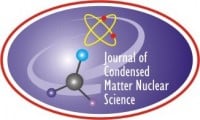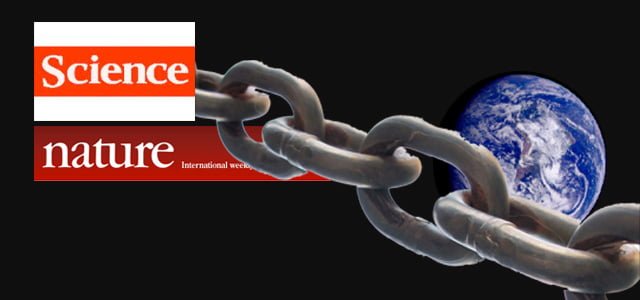 The recently published Volume 12 December 2013 Journal of Condensed Matter Nuclear Science has an article detailing censorship by science journals.
The recently published Volume 12 December 2013 Journal of Condensed Matter Nuclear Science has an article detailing censorship by science journals.
“How the Flawed Journal Review Process Impedes Paradigm Shifting Discoveries” by P.A. Mosier-Boss, L.P. Forsley, and F.E. Gordon describes the experience of these researchers as they submitted papers describing their low-energy nuclear reaction (LENR ) experiments to mainstream science journals.
From the Abstract:
The purpose of scientific journals is to review papers for scientific validity and to disseminate new theoretical and experimental results. This requires that the editors and reviewers be impartial. Our attempt to publish novel experimental results in a renowned physics journal shows that in some cases editors and reviewers are not impartial; they are biased and closed-minded. Although our subject matter was technical, its rejection was not: it was emotionally charged. It was an agenda-laden rejection of legitimate experiments that were conducted in US DoD and DoE laboratories. This paper describes the flawed journal review process, detailing our own case and citing others. Such behavior on the part of editors and reviewers has a stifling effect on innovation and the diffusion of knowledge.
© 2013 ISCMNS. All rights reserved. ISSN 2227-3123
Noting that the rejection of revolutionary science “is hardly a new phenomenon”, the authors quote from Responsible Conduct of Research by A.E. Shamoo and D.B. Resnik:
History provides us with many examples of important theories that were resisted and ridiculed by [reviewers of] established researchers, such as Gregory Mendel’s laws of inheritance, Barbara McLintock’s gene jumping hypothesis, Peter Mitchell’s chemiosmostic theory, and Alfred Wegener’s continental drift hypothesis. –Shamoo and Resnik
Shamoo and Resnick explain what these decisions regarding new energy research have meant:
As a result of this controversy, it has been difficult to conduct peer-reviewed work on cold fusion, because mainstream physics journals select reviewers with strong biases against cold fusion.
Boss, Forsely, and Gordon had submissions to journals rejected by reviewers who knew little about the phenomenon or the instruments involved, and didn’t attempt to learn. The authors found “the lack of curiosity and the unwarranted, surprisingly emotional responses” shown by some reviewers “disturbing”.
The consequences are far-reaching:
One immediate and long lasting effect of journals refusing to publish papers on as yet controversial observations is the elimination of a field of research and the diminution of scientists and engineers working in it. Without peer-reviewed publications, university faculty are precluded from funding as well as students, as no student will pursue an unrecognized field where jobs do not exist. Scientists are unable to find funds or management support. Entrepreneurs are limited because it is not likely that corporate angels or venture capitalists will risk funds on a technology, which is denigrated by leading scientists and subject to ridicule. In 1991, Nobel Laureate Julian Schwinger [38] aptly summarized the problem when he wrote:
“The pressure for conformity is enormous. I have experienced it in editors’ rejection of submitted papers, based on venomous criticism of anonymous referees. The replacement of impartial reviewing by censorship will be the death of science.”
Indeed, this whole situation is a “Catch-22” [39]; a situation named for the war novel in which a pilot who claims he is crazy so he wouldn’t have to fly missions, but by refusing to fly missions he proved he was sane! Our Catch-22 is that both DoE and DoD have unequivocally stated that until “first-tier” journals, like Science and Nature, publish papers inn this field, they will not fund programs. But, editors of these journals have stated they would not publish papers without DoE acceptance of the phenomena: a Catch-22. –Mosier-Boss, Forsley, and Gordon.
The Journal of Condensed Matter Nuclear Science (JCMNS) is published by the International Society of Condensed Matter Nuclear Science (ISCMNS).
Read the article “How the Flawed Journal Review Process Impedes Paradigm Shifting Discoveries” in Volume 12 December 2013 [.pdf]


In climate science, in biology, in LENR, there is an emerging underground concern about the unethical barrier against debate, in the name of pretended rationality…
All that groupthink is not new, but it is becoming, because of globalization, morea and more monolitithic and can no more be circumvented.
Notice how the JJAP, that Pam says is a japanese equivalent of Science or nature, is pathologically ignored as a peer review journal.
See how peer-reviewed articles in naturwissenschaften, or Journal of analytic chemistry are ignored by Wikipedia.
In others controversies, not only we have seen nature and Science victims of clear fraud and trash TV behaviors, but we also have recognized/admitted/conformed evidences of manipulation of peer-review, influence on peer-reviewers (positive and negative), and bullying to force ruind of dissenting journals who peer-reviewed dissenting article.
It is No news for LENR followers who have observed that since long, but it is a general case we know it today.
the worst is that the “top journal” are now the “most rotten”, not depite but because of their status.
I also see the desperate manipulation to make people blame the corruption of money, while it is clear the corruption is linked to academic way of taking decision, by consensus and peer-review, instead of by business success or failure.
As taleb says I trust more the people greedy for money, than people greedy of their peer recognitions.
It is shocking all my education, but like LENR reality, I have to painfully admit I was wrong.
Thanks to all those Oil corp, big multinational, greedy scientists, greedy engineers, ambitious entrepreneurs and scientists who too the risk to be treated as stupid
Alain, could not agree more, it is so sad that Science is no longer a respected occupation.
Brought down by incompetent, mediocre abilities and an agenda driven establishment that see’s the Truth as nothing but an irritating obstacle to be overcome at all costs, and a sheep like community only to happy to follow distortion lies and Dogma to protect their own worthless positions and funding.
Luckily there are still just a few worthy examples of true scientists, who have to spend most of their time battling their colleagues closed-minded fears, peer-reviewers and the comics laughingly called science and “premier journals” and a place called wiki-rubbish where any sane person would never believe a word that is written after the irrational changes to Truth allowed by it’s establishment.
We can only look forward to a better World when perhaps an enlightenment of some kind will put Truth and concern above what is taught as important today.
At 67 years old I feel a strong regret and embarrassment for my generation, seeing the self-serving, non-caring World we have passed on and left to our children, where any lies and corruption are justified by industry, governments media and individuals for cheap self-gain.
Also worth taking note of:
Nobel Winner Declares Boycott of Top Journals
http://www.theguardian.com/science/2013/dec/09/nobel-winner-boycott-science-journals
Yes, “Everybody knows that the dice are loaded…” (Leonard Cohn). So cut the Gordian Knot the way Rossi did.
http://www.youtube.com/watch?v=mUu2rz8WhZg
Unfortunately, the “venomous criticism” Schwinger referred to often occurs in the LENR community also.
Conformity must have conferred a Darwinian advantage for millennia since it is required for group survival.
I suspect that most people will adapt to group norms (e.g., patriotism, ethnic/religious solidarity, etc.) in a
chameleon-like way, i.e., a good patriot in “country A” would be a patriot in “country B” even if “A” and “B”
were enemies – allegiance being an accident of birth.
I recall (but cannot find the article) about an case in which about 15 mathematicians of a university
department were colluding with a psychologist in an experiment to test conformity. Fourteen were informed
beforehand that a guest lecturer would make obvious mistakes during the talk, but that they should show
outward signs of approval and ask questions which indicated they understood everything fully. The one
remaining, uninformed subject never spoke for fear of looking foolish to his peers.
The famous “Asch conformity experiments” –
http://en.wikipedia.org/wiki/Asch_conformity_experiments
– show how easily influenced we are by group pressure.
An entertaining video of the experiments is at: http://www.youtube.com/watch?v=NyDDyT1lDhA
Why don’t they just submit their papers to the Journal of Nuclear Physics?
http://www.journal-of-nuclear-physics.com/
In a 2012 paper “Social Aspects of Cold Fusion: 23 Years Later” published by Progress in Physics, author Ludwik Kowalski touches on this subject and concludes:
“The CF controversy is unprecedented in terms of its duration, intensity, and caliber of adversaries on both sides of the divide.
Huizenga and Fleischmann were indisputable leaders in nuclear science and electrochemistry. CMNS researchers are mostly also Ph.D. level scientists. The same is true for those scientists who believe that the announced discovery of CF was a “scientific fiasco”. We are still waiting for at least one reproducible-on-demand demonstration of a nuclear effect resulting from a chemical (atomic) process.
In the case of CF the self-correcting process of scientific development emphasized by Huizenga has not worked. This fiasco seems to be due to the fact that scientists appointed to investigate CF claims did not follow the rules of scientific methodology”
This “unprecedented controversy” in science continues today, almost two years after the authors’ conclusion, even though we now have had independent testing of Rossi, reproducible ECat energy production in “beyond known chemical and therefore nuclear” quantities. This fiasco of controversy continues even though numerous LENR Energy patents have since been granted in the U.S and abroad. See: NASA, SPAWAR, Rossi, Brillouin, Defkalian.
The ignoring of ideas that look somewhat queer is of all times and the rejection of such ideas is called “common sense”. Look at the e-Cat Site the articles “Belgian LANR Patents” and “LANR by Coulomb Explosion”. If you like some ideas about the catalyst for Ni-H atom-transmutation look at the article “Cold Fusion Catalyst”. Season’s Greetings. Jan especially to Ben and John Maguire.